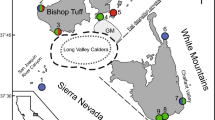Abstract
The matrix of the Pliocene volcaniclastics from the Akrotiri area of the Santorini island (Greece) is dominated by clinoptilolite. Smectite, occasionally illite-smectite, opal-CT, cristobalite and mordenite are also present. The clinoptilolite-rich samples were heated at 460 and 560°C for 12 h and the reductions in the intensity of the 020 diffraction peak were measured. Electron microprobe analysis (EMPA) was then used to study the chemical composition of the clinoptilolite. Statistical analysis proved a strong and quantifiable relationship between the reduction of the 020 diffraction peak of the clinoptilolite and the Na/K ratio. A representative set of microprobe analyses of clinoptilolite was performed before any correlation with thermal behavior was attempted. The presence of K in the structure of clinoptilolite as well as its relationship with Na are most important in the thermal behavior of clinoptilolite.
Similar content being viewed by others
References
Alberti, A. (1975) The crystal structure of two clinoptilolites. Tschermarks Mineralogische und Petragraphische Mitteilungen, 22, 25–37.
Alletti, A. (1972) Polymorphism and crystal-chemistry of heulandites and clinoptilolites. American Mineralogist, 57, 1448–1462.
Alietti, A., Gottardi, G. and Poppi, L. (1974) The heat behavior of the cation exchanged zeolites with heulandite structure. Tschermarks Mineralogische und Petrographische Mitteilungen, 21, 291–298.
Alietti, A., Brigarti, M.F. and Poppi, L. (1977) Natural Carichi clinoptilolites (heulandites of group 3): New data and review. Neues Jahrbuch fur Mineralogie Monatshefte, H11, 493–501.
Armbruster, T. (1993) Dehydration mechanism of clinoptil-olite and heulandite: Single-crystal X-ray study of Na-poor, Ca-, K-, Mg-rich clinoptilolite at 100 K. American Mineralogist, 78, 260–264.
Armbruster, T. and Gunter, M.E. (1991) Stepwise dehydration of heulandite-clinoptilolite from Succor Creek, Oregon, USA: A single-crystal X-ray study at 100 K. American Mineralogist, 76, 1872–1883.
Bish, D.L. (1984) Effects of exchangeable cation composition on the thermal expansion/contraction of clinoptilolite. Clays and Clay Minerals, 32, 444–452.
Bish, D.L. (1988) Effects of composition on the dehydration behavior of clinoptilolite and heulandite. Pp. 565–576 in: Occurrence, Properties and Utilization of Natural Zeolites (D. Kallo and H.S. Sherry, editors). Akademiai Kiado, Budapest.
Bish, D.L. (1993) Thermal behavior of natural zeolites. Pp. 259–269 in: Natural Zeolites ’93: Occurrence, Properties, Use (D.W. Ming and E. A. Mumpton, editors). International Committee on Natural Zeolites, Brockport, New York.
Boles, J.R. (1972) Composition, optical properties, cell dimensions, and thermal stability of some heulandite group zeolites. American Mineralogist, 57, 1463–1493.
Boles, J.R. and Surdam, R.C. (1979) Diagenesis of volcano-genie sediments in a Tertiary saline lake; Wagon Bed Formation, Wyoming. American Journal of Science, 279, 832–853.
Coombs, D.S. et al. (1998) Recommended nomenclature for zeolite minerals: Report of the Subcommittee on Zeolites of the International Mineralogical Association, commission on New Minerals and Minerals Names. European Journal of Mineralogy, 10, 1037–1081.
Dunham, A.C. and Wilkinson, E.C.E. (1978) Accuracy, precision and detection limits of energy-dispersive electron-microprobe analyses of silicates. X-Ray Spectrometry, 7, 50–56.
Kitsopoulos, K.P. (1995) The mineralogy, geochemistry, physical properties and possible industrial applications of volcanic zeolitic tuffs from Santorini and Polyegos Islands, Greece. Ph.D. thesis, Leicester University, Leicester, UK, 442 pp.
Kitsopoulos, K.P. (1997) Genesis of heulandite group of minerals in pyroclastics (Santorini, Greece). Implications for models of zeolitization of volcaniclastic materials. Zeolite ’97, 5th International Conference on the Occurrence, Properties, and Utilization of Natural Zeolites, Ischia (Naples, Italy), September 1997. Program and Abstracts Volume, 195–197.
Kitsopoulos, K.P. and Dunham, A.C. (1998) Compositional variations of mordenite from Polyegos island, Greece: Na-Ca and K-rich mordenite. European Journal of Mineralogy, 10, 569–577.
Koyama, K. and Takeuchi, Y. (1977) Clinoptilolite: the distribution of potassium atoms and its role in thermal stability. Zeitschrift fur Kristallographie, 145, 216–239.
Mason, B. and Sand, L.B. (1960) Clinoptilolite from Patagonia: The relationship between clinoptilolite and heulandite. American Mineralogist, 45, 341–350.
Mumpton, F.A. (1960) Clinoptilolite redefined. American Mineralogist, 45, 351–369.
Shepard, A.O. and Starkey, H.C. (1966) The effect of exchanged cations on the thermal behaviour of heulandite and clinoptilolite. Mineralogical Society of India, IMA Volume, 155–158.
Tsolis-Katagas, P. and Katagas, C. (1989) Zeolites in pre-caldera pyroclastic rocks of the Santorini Volcano, Aegean Sea, Greece. Clays and Clay Minerals, 37, 497–510.
Author information
Authors and Affiliations
Corresponding author
Rights and permissions
About this article
Cite this article
Kitsopoulos, K.P. The Relationship between the Thermal Behavior of Clinoptilolite and Its Chemical Composition. Clays Clay Miner. 49, 236–243 (2001). https://doi.org/10.1346/CCMN.2001.0490306
Received:
Revised:
Published:
Issue Date:
DOI: https://doi.org/10.1346/CCMN.2001.0490306




